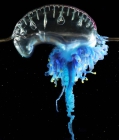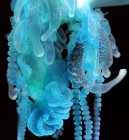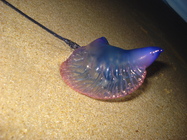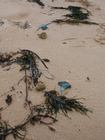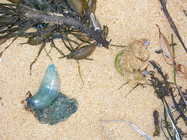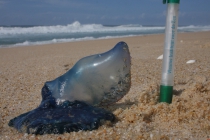
| Intro | | Search taxa | | Browse taxa | | Distributions | | Terminology | | References | | Statistics | | Online sources | | Tutorial | | Log in |
Traits taxon detailsPhysalia physalis (Linnaeus, 1758)
135479 (urn:lsid:marinespecies.org:taxname:135479)
accepted
Species
marine,
recent only
(of ) Linnaeus, C. (1758). Systema Naturae per regna tria naturae, secundum classes, ordines, genera, species, cum characteribus, differentiis, synonymis, locis. [The system of nature through the three kingdoms of nature, according to classes, orders, genera, species, with characters, differences, synonyms, places.]. <em>Impensis Direct. Laurentii Salvii. Holmiae [Stockholm].</em> 1(10) [iii], 824 p., available online at https://biodiversitylibrary.org/page/726886
page(s): 657 [details] Available for editors
Schuchert, P.; Choong, H.; Galea, H.; Hoeksema, B.; Lindsay, D.; Manko, M.; Pica, D. (2025). World Hydrozoa Database. Physalia physalis (Linnaeus, 1758). Accessed through: Marine Species Traits editorial board (2025) Marine Species Traits at: https://marinespecies.org/traits/aphia.php?p=taxdetails&id=135479 on 2025-05-04
Marine Species Traits editorial board (2025). Marine Species Traits. Physalia physalis (Linnaeus, 1758). Accessed at: https://marinespecies.org/traits/aphia.php?p=taxdetails&id=135479 on 2025-05-04
Date action by
original description
(of ) Linnaeus, C. (1758). Systema Naturae per regna tria naturae, secundum classes, ordines, genera, species, cum characteribus, differentiis, synonymis, locis. [The system of nature through the three kingdoms of nature, according to classes, orders, genera, species, with characters, differences, synonyms, places.]. <em>Impensis Direct. Laurentii Salvii. Holmiae [Stockholm].</em> 1(10) [iii], 824 p., available online at https://biodiversitylibrary.org/page/726886
page(s): 657 [details] Available for editors context source (RAS) Australian Antarctic Data Centre. , available online at https://data.aad.gov.au/aadc/biodiversity/ [details] context source (Bermuda) Totton, A. K. 1936. Plankton of the Bermuda Oceanographic Expeditions. VII. Siphonophora taken during the year 1931. Zoologica (N. Y.) 21 (4): 231-240. , available online at https://www.biodiversitylibrary.org/page/51096617 [details] context source (Hexacorallia) Fautin, Daphne G. (2013). Hexacorallians of the World. (look up in IMIS) [details] additional source Calder, D. (2003). Checklist of Hydroids, hydromedusae and siphonophores reported from the Bay of Fundy. [details] additional source Linkletter, L. E. (1977). A checklist of marine fauna and flora of the Bay of Fundy. <em>Huntsman Marine Laboratory, St. Andrews, N.B.</em> 68: p. [details] additional source Pollock, L.W. (1998). A practical guide to the marine animals of northeastern North America. Rutgers University Press. New Brunswick, New Jersey & London. 367 pp., available online at http://books.google.com/books?id=i1AmT31cuR4C [details] additional source Pugh, P. R. & Gasca, R. (2009). Siphonophorae (Cnidaria) of the Gulf of Mexico. Pp. 395–402. In: Felder, D.L. and D.K. Camp (eds.), Gulf of Mexico–Origins, Waters, and Biota. <em>Biodiversity.</em> Texas A&M Press, College Station, Texas. [details] additional source Liu, J.Y. [Ruiyu] (ed.). (2008). Checklist of marine biota of China seas. <em>China Science Press.</em> 1267 pp. (look up in IMIS) [details] Available for editors additional source Cairns, S.D., L. Gershwin, F.J. Brook, P. Pugh, E.W. Dawson, O.V. Ocaña, W. Vervoort, G. Williams, J.E. Watson, D.M. Opresko, P. Schuchert, P.M. Hine, D.P. Gordon, H.I. Campbell, A.J. Wright, J.A.Sánchez & D.G. Fautin. (2009). Phylum Cnidaria: corals, medusae, hydroids, myxozoans. <em>in: Gordon, D.P. (Ed.) (2009). New Zealand inventory of biodiversity: 1. Kingdom Animalia: Radiata, Lophotrochozoa, Deuterostomia.</em> :59-101., available online at https://repository.si.edu/handle/10088/8431 [details] Available for editors source of synonymy Pugh, P. R. (2019). Two new species of <em>Bargmannia</em> (Pyrostephidae, Physonectae, Siphonophorae). <em>Zootaxa.</em> 4686(1): 74-82., available online at https://doi.org/10.11646/zootaxa.4686.1.3 page(s): 85 [details] source of synonymy Pugh, P. R. (2019). A history of the sub-order Cystonectae (Hydrozoa: Siphonophorae). <em>Zootaxa.</em> 4669(1): 1-91., available online at https://doi.org/10.11646/zootaxa.4669.1.1 page(s): 74; note: taxonomic history, synonymy opinion: In this paper we only recognise one species of the family Physaliidae, i.e. Physalia physalis. Although there is, presently, a push by mainly Australian and ... taxonomic history, synonymy
opinion: In this paper we only recognise one species of the family Physaliidae, i.e. Physalia physalis. Although there is, presently, a push by mainly Australian and New Zealand workers to establish several more species they would need to establish definite morphological differences from P. physalis and, indeed, any of the c. 50 synonyms (see Appendix) that cannot be accounted for by changes occurring during the various stages of development of the species. redescription Totton, A. K. (1960). Studies on Physalia physalis (L.). Part 1. Natural History and morphology. <em>Discovery Reports.</em> 30: 301-368., available online at https://www.biodiversitylibrary.org/page/5609085 [details] ecology source Totton, A. K. (1960). Studies on Physalia physalis (L.). Part 1. Natural History and morphology. <em>Discovery Reports.</em> 30: 301-368., available online at https://www.biodiversitylibrary.org/page/5609085 [details] ecology source Kirkpatrick, P.A.; Pugh, P.R. (1984). Siphonophores and velellids: keys and notes for the identification of the species. <i>Synopses of the British fauna (new series)</i>, 29. E.J. Brill/W. Backhuys: London, UK. ISBN 90-04-07470-8. vi, 154 pp. (look up in IMIS) [details] biology source Munro, C.; Vue, Z.; Behringer, R. R.; Dunn, C. W. (2019). Morphology and development of the Portuguese man of war, Physalia physalis. <em>Scientific Reports.</em> 9(1)., available online at https://doi.org/10.1038/s41598-019-51842-1 [details]  Present Present  Inaccurate Inaccurate  Introduced: alien Introduced: alien  Containing type locality Containing type locality
Marine Life Information Network - UK
To Barcode of Life (9 barcodes) To Biodiversity Heritage Library (43 publications) To Biological Information System for Marine Life (BISMaL) To European Nucleotide Archive, ENA (Physalia physalis) To GenBank (16 nucleotides; 33 proteins) To PESI To USNM Invertebrate Zoology Cnidaria Collection (41 records) To Yale Peabody Museum of Natural History (YPM IZ 106757) To ITIS |
